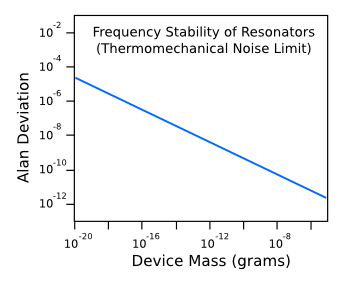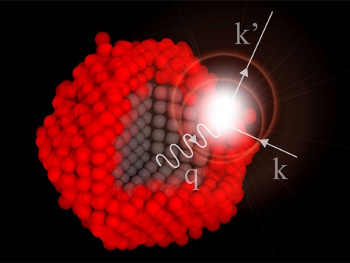
The Nanoscale Shakes
May 2, 2016 There was much variety in rock music at the start the British Invasion in the 1960s, including a few, unusual, minimalist recordings. One of these was Hippy Hippy Shake, which was a somewhat popular release by The Swinging Blue Jeans in 1964.[1] This song was covered, also by The Beatles on their Live at the BBC album in 1994. | The hula hoop, a hip shaking phenomenon of the late 1950s and early 1960s. An adult-sized hula hoop makes a good length reference, since they are almost exactly a meter in diameter. They became popular in the 1960s when Wham-O marketed a plastic version. (A 1962 woodcut entitled, "Hoola Hoop," by an unknown artist, from the National Archives and Records Administration, National Archives Identifier, 558912, via Wikimedia Commons.) |
 |
| Left, a doubly-clamped beam resonator, right, a simple cantilever, each fabricated on a silicon wafer. The length dimension L of these devices is typically of the order of a micrometer (1000 nanometer), or less. Not shown are the connections for actuation, typically electrostatic, and sensing, typically piezoresistive. (Created using Inkscape.) |
 | Thermomechanical limit of resonator noise as a function of mass. The Alan deviation is a measure of noise-induced frequency spread, (δf/f). (Drawn using Inkscape from data in ref. 4.[4]) |
 | Movement of a 40 μm × 10 μm graphene cantilever caused by Brownian motion. (Drawn using Inkscape from data in ref. 5.[5]) |
"For some applications, like catalysis, thermoelectrics, or superconductivity, these large vibrations may be good, but for other applications like LEDs or solar cells, these vibrations are undesirable... Now that we have proven that surface vibrations are important, we can systematically design materials to suppress or enhance these vibrations."[7]
 | Artist's impression of a nanocrystal, showing the interaction of a phonon (q) with an electron wave vector (k). (© ETH Zurich image by Deniz Bozyigit.) |
References:
- Swinging Blue Jeans, The Hippy Hippy Shake, YouTube Video by TheVideoJukeBox4, January 11, 2012.
- A. N. Cleland and M. L. Roukes, "Noise processes in nanomechanical resonators," J. Appl. Phys., vol. 92, no. 5 (September 1, 2012), pp. 2758-2769, doi: 10.1063/1.1499745. A PDF version of this paper can be found here.
- A. N. Cleland, "Thermomechanical noise limits on parametric sensing with nanomechanical resonators," New Journal of Physics,vol. 7 (November 29, 2005), pp. 235-251.
- Marc Sansa, Eric Sage, Elizabeth C. Bullard, Marc Gély, Thomas Alava, Eric Colinet, Akshay K. Naik, Luis Guillermo Villanueva, Laurent Duraffourg, Michael L. Roukes, Guillaume Jourdan, Sébastien Hentz, "Frequency fluctuations in silicon nanoresonators," Nature Nanotechnology, February 29, 2016, doi:10.1038/nnano.2016.19. Available also on arXiv.
- Melina K. Blees, Arthur W. Barnard, Peter A. Rose, Samantha P. Roberts, Kathryn L. McGill, Pinshane Y. Huang, Alexander R. Ruyack, Joshua W. Kevek, Bryce Kobrin, David A. Muller, and Paul L. McEuen, "Graphene kirigami," Nature, vol. 524, no. 7564 (August 13, 2015, pp. 204-207, doi:10.1038/nature14588.
- Deniz Bozyigit, Nuri Yazdani, Maksym Yarema, Olesya Yarema, Weyde Matteo Mario Lin, Sebastian Volk, Kantawong Vuttivorakulchai, Mathieu Luisier, Fanni Juranyi, and Vanessa Wood, "Soft surfaces of nanomaterials enable strong phonon interactions," Nature, Advanced Online Publication (March 9, 2016), doi:10.1038/nature16977.
- Atomic Vibrations in Nanomaterials, ETH-Zurich Press Release, March 9, 2016.
- Nuri Yazdani, Animation of a vibrating lead sulfide nanocrystal (1.7 MB MP4 File).